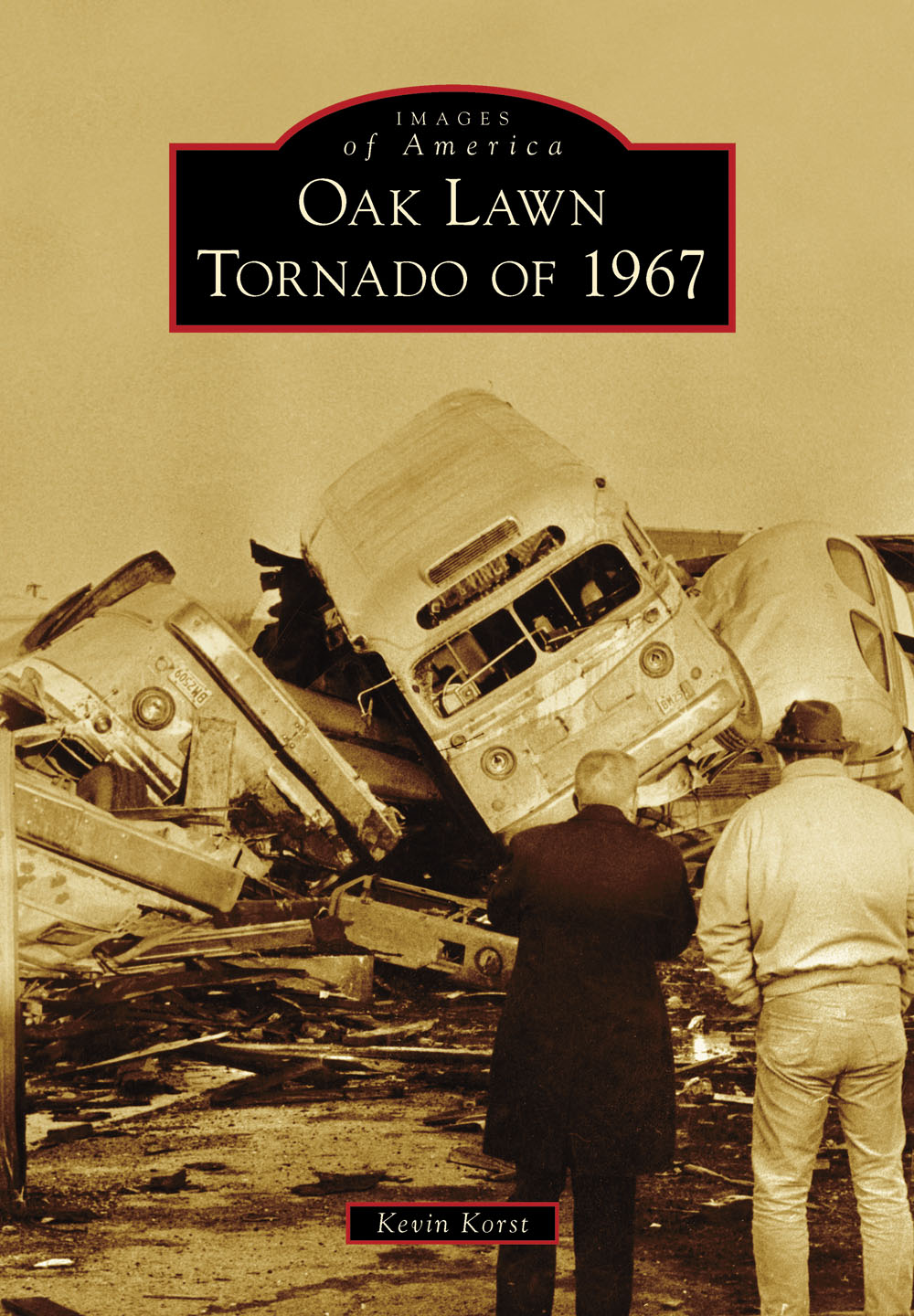
IMAGES
of America
OAK LAWN
TORNADO OF 1967

Propelled with a force that is difficult to comprehend, this wedding album sits deeply embedded in the side of a tree. Those who witnessed that day remember the deafening sound and unforgettable images created by the tornados fury. (Photograph by David A. Johnston; donated to the Oak Lawn Public Library by Tom Johnston.)
ON THE COVER: Near Ninety-fifth Street and Menard Avenue, the Suburban Transit Company and its fleet of buses were crushed by the tornados immense power. Thrown on top of each other like toys, the vehicles twisted remains are looked upon by two men. (Photograph by Gary Settle; courtesy of the Oak Lawn Public Library.)
IMAGES
of America
OAK LAWN
TORNADO OF 1967
Kevin Korst

Copyright 2014 by Kevin Korst
ISBN 978-1-4671-1045-7
Ebook ISBN 9781439644461
Published by Arcadia Publishing
Charleston, South Carolina
Library of Congress Control Number: 2013933397
For all general information, please contact Arcadia Publishing:
Telephone 843-853-2070
Fax 843-853-0044
E-mail
For customer service and orders:
Toll-Free 1-888-313-2665
Visit us on the Internet at www.arcadiapublishing.com
To Deanne and Elise, and for my family and friends
CONTENTS
ACKNOWLEDGMENTS
Since its inception in 1961, the Oak Lawn Public Librarys Local History Program has been at the forefront of preserving the communitys past. Through the last six decades, numerous individuals have guided the program in new and exciting directions. Without the hard work of staff members such as Katherine Trimble, Dee Kopf, Carol Adams, Peggy Nevins, Mary Lou Harker, Lillian McAninch, Gordon Welles, Gerald Anderson, William Goodfellow, Maritza Ruiz, and Maureen Gilligan, much of the collection we have today would not exist.
I would also like to acknowledge the Oak Lawn Community Library Foundation, Friends of the Oak Lawn Library, and the Oak Lawn Public Librarys board of trustees for their continued support of the Local History Program, as well as the efforts of volunteers, especially Pam Koziol, and interns, whose time and dedication help make the program a success. In addition, a thank-you goes out to the Oak Lawn residents who have donated or loaned historical artifacts. We are forever grateful for your contributions to preserving the villages history.
This book is by no means the complete and definitive history of the Oak Lawn Tornado. If anyone has additional historical information, photographs, documents, or objects, they are urged to contact the Oak Lawn Public Librarys Local History Unit.
INTRODUCTION
In the midst of an unseasonably warm spring, Oak Lawn residents awoke on the morning of April 21, 1967, to beautiful sunny skies. While the weather in Chicagoland remained calm and clear, a massive line of thunderstorms was developing over northeastern Kansas and western Iowa. As the front pushed east, gathering in strength and producing damaging winds, the Weather Bureau (now the National Weather Service) issued a tornado watch at 1:50 p.m. for much of central and northern Illinois. Two hours later, the town of Belvidere, located 65 miles northwest of Chicago, was struck by a deadly twister, while the communities of Fox River Grove, North Barrington, and Lake Zurich were hit by a second F4 tornado at 5:03 p.m. Causing more than 20 deaths and hundreds of injuries, these tornados were among the 17 reported to have touched down throughout Illinois that day. With chaos erupting at distant points across the state and a tornado warning now in full effect, residents were leaving work, running errands, or preparing for the coming weekend, unaware of what would emerge from the powerful storm bearing down on them.
At 5:15 p.m., 20 miles southwest of Oak Lawn in present-day Romeoville, an off-duty Weather Bureau employee was keeping an eye on the rapidly declining conditions. Looking up to the sky over his home, he noticed a rotating mass of clouds passing almost directly overhead. Minutes later, a Mr. Lace of the Little Red Schoolhouse Nature Center, positioned near Ninety-ninth Street and Willow Springs Road, witnessed the still-rotating cloud move just south of him. As the storm rumbled by, the changing pressure popped his ears, the building in which he stood shook, and cars in the parking lot bounced off the pavement. Running to the phone as large hail began to fall, Lace contacted the Weather Bureau to let them know of the impending danger. His call was the first official indication of a tornado, but the report was never forwarded, as the bureau office lost telephone service shortly after it was received.
Moving on a northeasterly course, the now-visible funnel gradually lowered until touching down at 5:24 p.m. just east of Eighty-eighth Avenue, near the current site of Moraine Valley Community College. Unleashing blinding rain, golf ballsized hail, and winds approaching 200 miles per hour, the twister picked up mud and uprooted trees until making contact with its first structures on Eighty-third Avenue. Damaging or destroying a number of houses, it crossed the Tri-State Tollway into Chicago Ridge before colliding with the Starlite Drive-In and moving into the heart of Oak Lawn.
At Ninety-fifth Street and Southwest Highway, shoppers and diners filled the stores and restaurants while a number of motorists waited at stoplights. Without warning, the tornado crashed through, ripping apart the nearby buildings and tossing cars in every direction. Oak Lawn Community High School, Shoots Lynwood Lounge, Fishers Motel, the Fairway Super Mart, Sherwood Forest Restaurant, Basils Service Station, and the Standard Service Station were among the structures heavily damaged or destroyed in this area alone.
Continuing northeast, the tornado tore apart the Suburban Transit Company, leaving 19 mangled buses in its wake, and wrecked numerous homes, along with much of St. Gerald. Although the path narrowed considerably at times, its full might was brought down on Cicero Avenue between Ninety-first Street and Southwest Highway, leaving the Airway Trailer Park, the Oak Lawn Roller Rink, the Oak Lawn Dairy Basket, McDonalds, and other buildings in utter ruin. Traversing the boundaries of Oak Lawn, the twister relentlessly threw itself into the neighboring communities of Hometown and Evergreen Park, leveling dozens of houses and businesses before working its way into Chicago and eventually disappearing over the waters of Lake Michigan.
Moving on the ground at roughly 60 miles per hour, the tornado traveled 16 miles in approximately 15 minutes, creating a swath of destruction up to 600 feet in width that left at least 33 people dead and nearly 500 injured. In the minutes and hours that followed, countless rescue workers, volunteers, engineers, repairmen, soldiers, and government officials arrived in the village to offer support. With many feverishly digging through the mountains of rubble in search of survivors and victims, stories of heroism, compassion, and determination poured in from every corner of Oak Lawn. Mayor Fred M. Dumke, village clerk Ernie Kolb, director of building and zoning Karl Faitz, fire chief Alan Hulett, police chief Gerhardt Hein, Cook County sheriff Joseph I. Woods, and others worked for days to organize relief efforts and utilize available resources.
Within a week, much of the debris had been cleared away and regular electric, telephone, and gas service had returned. For the estimated 600 people left without a place to stay, temporary trailers were established near Christ Community Hospital, and low-interest loans were made available to those replacing homes or businesses. Despite the unimaginable scope of the devastation, which totaled more than $20 million, the people of Oak Lawn pulled together and worked toward the common goal of recovery. Over the next 12 months, the afflicted structures were repaired or rebuilt, and on April 21, 1968, a memorial ceremony was held at Oak Lawn Community High School. Marking the tornados one-year anniversary, the service honored the men, women, and children who lost their lives.
Next page









